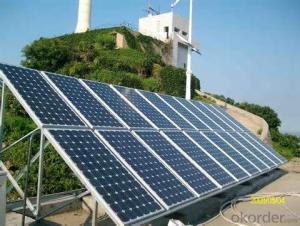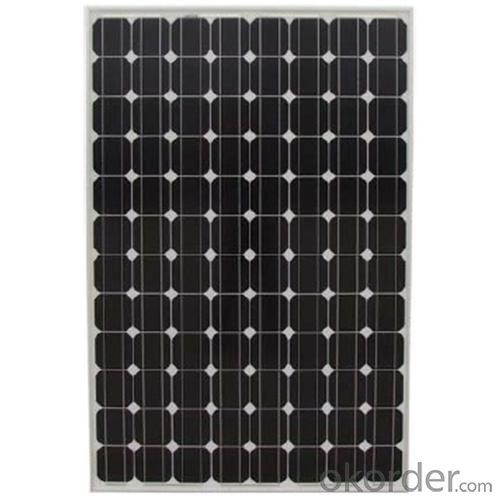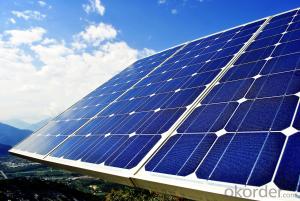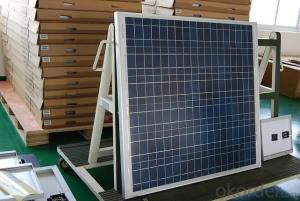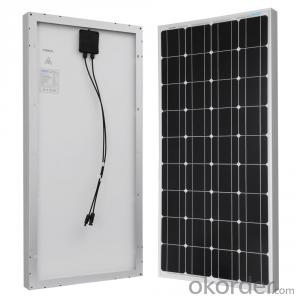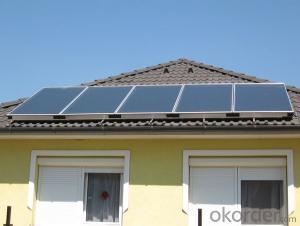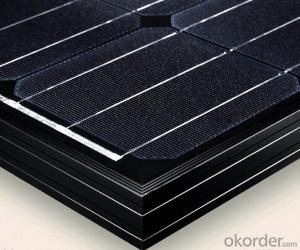160W Cis Poly Solar Module with High Efficiency
- Loading Port:
- Tianjin
- Payment Terms:
- TT OR LC
- Min Order Qty:
- 1 watt
- Supply Capability:
- 100000 watt/month
OKorder Service Pledge
OKorder Financial Service
You Might Also Like
Specification
Product Description:
1.Structure of Solar Module Description
CNBM Solar's photovoltaic module is designed for designed for large electrical power requirement. It is the optimal choice for both on-grid and off-grid power systems. CNBM Solar offers high performance of power per square foot of solar array.
2.Main Features of the Solar Module
Solar Cell: High efficency crystalline solar cell. Even if under the weak light, the solar module can produce maximum power output.
Tempered glass: Anti-reflecting coating and high transmission rate glass increase the power output and mechanical strength of solar module.
EVA and TPT: Using high quality EVA and TPT to prevent destroying and water.
Strong aluminum frames to strengthen the load hold and to stand against high wind.
Junction box: Multi function junction box with water proof.
Long lifetime: ≥25 years; Less power decrease.
Good performance of preventing from atrocious weather such as wind and hails.
Resisting moisture and etching effectively, not effected by geology.
The certificate issued by international authority: UL, TUV, IEC, VDE, CE.

Solar panel working process
In addition to being the ultimate source of all life on earth, the sun is an infinitely renewable, completely pollution-free source of electricity. Instead of burning fossil fuels dug up from the ground in a big power plant – a very 19th century, industrial age approach, when you think about it – solar panels convert sunlight directly into electricity, with no harmful emissions.
The basic unit of a solar panel is a solar cell, which usually consists of one or two layers of silicon-based semiconductor wafers. When struck by the photons in sunlight, the solar cell generates an electrical charge due to the "photovoltaic effect" – which is a pretty good name, since it produces voltage from photons. The flow of these electrons moves in a steady electrical current from one side of the cell to the other.
Dozens of these PV cells are packaged together into solar modules, which in turn are packaged into solar panels that are mounted on a rooftop and arranged to maximize their hours of exposure to direct sunlight. Because the electricity generated by all those solar cells is direct current (DC), it is then sent to an inverter that transforms the power into the same alternating current (AC) used by the appliances in your home and the local utility electricity distribution grid. Increasingly, these inverters are getting "smart," providing data monitoring for solar installation performance and other grid integration services.
- Q: Can solar panels power a whole house?
- Yes, solar panels can power a whole house. With the right number of solar panels installed and optimal sunlight exposure, they can generate enough electricity to meet the energy needs of a typical household. However, it is important to consider factors such as the size of the house, energy consumption, and storage options to ensure a reliable and consistent power supply.
- Q: Also, where can solar panels be purchased in the Binghamton/Liberty/Jeffersonville area? Home Depot has some on their website I would like to see them in a store before purchasing or ordering them.
- Enacted okorder Hope that you find the above enclosed information useful. 09/9/20
- Q: Can any body tell me how much Electricity can 0 Standard solar panels produce in a day( in terms of Watts)Or else please tell me how many Watts is 5 volts of electricity?
- I am sure someone can tall you.
- Q: Can solar panels work in cloudy weather?
- Yes, solar panels can still work in cloudy weather, although their energy production may be reduced. Cloud cover reduces the amount of sunlight reaching the panels, resulting in a lower output. However, modern solar panels are designed to generate electricity even in low-light conditions, making them still effective in producing energy during cloudy days.
- Q: Can I add reflectors or mirrors around the solar panels to increase the power they generate?
- You could (an example of concentrating sunlight is called cloud gain, where the edge of a cloud will intensify sunlight as it passes between the sun and your panels), but that will make your panels run hotter and will probably reduce their life. It's better from a system design standpoint to simply get another panel or two. DK
- Q: Can solar panels be used to power a space station?
- Yes, solar panels can be used to power a space station. Solar panels convert sunlight directly into electricity, and in space, where there is no atmosphere to scatter or absorb sunlight, they can generate a significant amount of power. Several space stations, including the International Space Station (ISS), rely on solar panels to generate electricity for various systems and experiments.
- Q: How do solar panels withstand hail and other extreme weather conditions?
- Solar panels are designed to be durable and withstand various weather conditions, including hail and extreme weather. They are typically made with tempered glass, which is highly resistant to impacts from hail and other debris. Additionally, the solar cells are encapsulated in a protective layer of materials such as ethylene-vinyl acetate (EVA) and fluoropolymer, which provide further protection against weather elements. The structural design and mounting systems also ensure that solar panels are securely installed to withstand strong winds. Overall, the combination of robust materials and careful construction allows solar panels to withstand hail and other extreme weather conditions.
- Q: I don't see much solar panels on people's houses where I live. I got a long time to go before doing so but I was planning on buying a few solar panels when I retire in the far future. In your opinion, is such an investment worth it? Would you buy them? I realize they are very expensive hence why I said when I retire. Thanks for your opinion
- Solar power is still an expensive way to purchase power, as of 2007, it was 38 cents per kwh while the cost of power from coal is 0.6 cents per kwh. Of course regulations have prevented new coal power stations from being built so it's really natural gas power stations at 5 cents a kwh that solar has to compete with. Solar is dropping in price but the best you can hope for is for it to reach parity with natural gas someday soon and it hasn't yet. The other issue is that you pay up front for solar power which as any economist will tell you is even more expensive and involves greater risks. However, as part of a strategy to become as self reliant as possible when you retire and have a fixed income, it's a reasonable prospect, not only will the technology become less expensive by then but at that point, fixing the price of the energy costs is more valuable than the cost of the energy. Focusing on personal finance and learning how to invest which very few people know how to do is more important right now. When you retire, hopefully you can afford to build a passive solar home with photovoltaic solar panels and wind turbines but still on the grid for efficient net metering and with a greenhouse where you can grow the staples that you need and perhaps even some biodiesel for your google driven car. Having a reasonable portfolio is really the only way to achieve that goal.
- Q: Can solar panels be used in areas prone to hurricanes?
- Yes, solar panels can be used in areas prone to hurricanes. However, it is important to ensure that the panels are properly installed and designed to withstand high wind speeds. Reinforcements, such as additional framing or anchoring systems, can be used to make the panels more resilient to hurricane conditions. Additionally, regular maintenance and inspections are necessary to ensure their stability and functionality.
Send your message to us
160W Cis Poly Solar Module with High Efficiency
- Loading Port:
- Tianjin
- Payment Terms:
- TT OR LC
- Min Order Qty:
- 1 watt
- Supply Capability:
- 100000 watt/month
OKorder Service Pledge
OKorder Financial Service
Similar products
Hot products
Hot Searches
Related keywords
